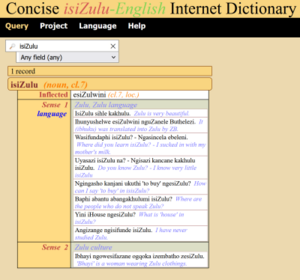CIEID – Concise isiZulu-English Internet Dictionary

The Concise isiZulu-English Internet Dictionary is a bilingual dictionary that emerged from a language teaching project at the Institute of African Studies at the University of Vienna. This endeavour was accompanied by the creation of a comprehensive set of digital learning materials (curriculum, grammar, exercises, texts, dictionary), all based on TEI (P5).
The dictionary has an experimental character, as it was the first at the ACDH-CH to be modelled in TEI Lex-0. It also served as a testbed for the development of the new lexicographic editor, the ˂TEI˃Enricher, and for experiments on semi-automatic data acquisition/creation for digital lexcial resources.
The focus in compiling the dictionary was on modern urban isiZulu, a variety belonging to the Nguni branch of the Southern Niger-Congo languages in southern Africa. The amaZulu people (about 12 million L1 speakers) live mainly in the KwaZulu-Natal province of the Republic of South Africa. With around a quarter of South Africa's population, isiZulu is the most widely spoken language in the country. It is one of the 11 official languages of South Africa.
The lexicographic data collection has been carried out along two lines. The main objective is to capture all lexical units needed for the teaching and learning of isiZulu, including high-frequency lexical units used in textbooks and typically needed for teaching the language. In addition, the focus was on data not found in other dictionaries. Particular attention was paid to neologisms and loanwords, although we are not aiming for completeness for the time being.
A corpus of digital isiZulu texts was used to compile the dictionary, which was put together from various internet sources, in particular online newspapers. A few contemporary literary works were also integrated. The data encoded in TEI (P5) was made searchable via NoSke and made available for lexicographical work. As of 3 June 2024, the published dictionary contained 15,417 lemmas (single and multi-word units) and 13,280 example sentences.